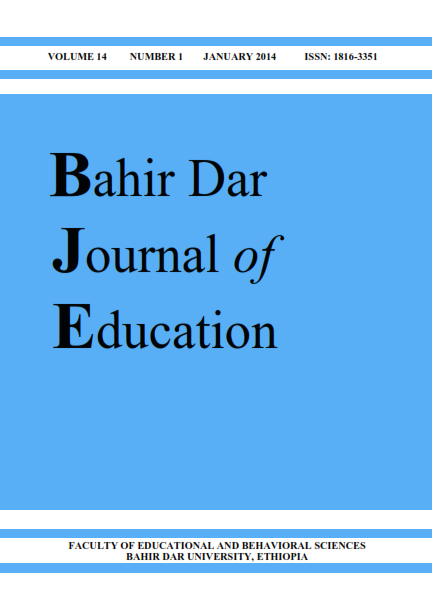The Influence of Time Perspective on Time Management and Risk Perception among University Students
Abstract
This research seeks to contribute to the knowledge base used when designing interactive education program and health promotion that support risk free teachinglearning milieu in Higher Education Institutions. A total of 286 participants completed Time Perspective Inventory Scales, Sexual and Drug Oriented Risk Perception Scales and Time Management Questionnaires. The result shows that respondents favored for present hedonistic and future time perspective with lower emphasis of past negative and fatalistic time orientation. There was strong positive correlation among past negative time perspective and sexual risk perception; future time perspective with drug risk perception, time management and procrastination. Future time; present hedonistic and present fatalistic time orientation predicted both drug and sexual risk perception. We concluded that the present, future time perspectives and demographic variables interact with one another to influence risk perception and time management practices, with recommendations of designing cognitive and behavioral interventions aimed at stimulating time management practices and risk perception behaviors among student population.References
Apostolidids, T., Fieulaine, N. and Soule, F. (2006). Future time perspective as predictor of Cannabis use: Exploring the role of substance perception among French adolescents. Addictive Behaviors, 31, 2339-2349
Britton, B.K. and Tesser, A. (1991). Effects of time-management practices on College grades. Journal of Educational Psychology, 83(3), 405-410
D`Alessio, M., Guarino, A., De Pascalis, V. and Zimbardo, P. G. (2003). Testing Zimbardo`s Stanford Time Perspective Inventory (STPI)-short form: An Italian study. Time & Society, 12 (2/3), 333-347
Fortunato, V.J. and Furey, J.T. (2010). The Theory of Mind Time: The relationships between thinking perspective and time perspective. Personality and Individual Differences, 48, 436-441
Gibbons, F.X. and Gerrard, M. (1995). Predicting Young Adults' Health Risk Behavior. Journal of Personality and Social Psychology, 69 (3), 505-517
Jonas, K. J. and Huguet, P. (2008). What day is today? A social-psychological investigation of into the process of time orientation. Personality and Social Psychology Bulletin, 34(4), 353-365
Jones, R. (2004). Relationships of sexual imposition, dyadic trust and sensation seeking with sexual risk behavior in young urban women. Research in Nursing and Health, 27, 185197
Kanazawa, S. and Hellberg, J. E. E. U. (2010). Intelligence and substance use. Review of General Psychology, 14(4), 382-396
Keough, K.A., Zimbardo, P.G. and Boyd, J.N. (1999). Who’ s Smoking, Drinking, and Using Drugs? Time Perspective as a Predictor of Substance Use. Basic and Applied Social Psychology, 21 (2), 149-164
Kloep, M., Hendry, M. P., Gardner, C. and Seage, C. H. (2010). Young people`s views of their present and future selves in two deprived communities. Journal of Community & Applied Social Psychology, 20, 523-524
Krejcie, R.V. and Morgan, D.W. (1970). Determining sample size for research activities. Educational and Psychological Measurement, 30, 607-610
Lee, T. and Breen, L. (2007). Young people`s perceptions and experiences of leaving high school early: An exploration. Journal of Community & Applied Social Psychology, 17, 329-346
Leikas, S., Lindeman, M., Roininen, K. & Lahteenmaki, L. (2009). Avoidance motivation, risk perception and emotional processing. European Journal of Personality, 23, 125147
Macan, T.H., Shahani, C., Dipboye, R.L. and Phillips, A.P. (1990). College students' time management: Correlations with academic performance and stress. Journal of Educational Psychology, 82 (4), 760-768
Milfont, T.L., Andrade, P.R., Belo, R. P. AND Pessoa, V.S. (2008). Testing Zimbardo Time Perspective Inventory in a Brazilian Sample. Interamerican Journal of Psychology, 42, 49-58
Phan, H.P. (2009). Examination of time perspective, hope, self-efficacy, and ethnic identity: A Structural equation model. Conference paper for the AARE, 2009, Canberra Australia
Phan, H.P. (2009). Future time perspective in socio-cultural contexts: A Discussion paper. Electronic Journal of Research in Educational Psychology, 7(2), 761-778
Rolison, M. R. & Scherman, A. (2003). College student risk-taking from three perspectives. Adolescence, 38, 689-704
Rothspan, S. & Read, S. J. (1996). Present versus future time perspective and HIV risk among heterosexual college students. Health Psychology, 15, 131-134.
Scanlan, J. N., Bundy, A. C. Matthews, L. R. (2010). Investigating relationships of meaningful time use and health in 18- to 25-years-old unemployed people in New South Wales, Australia. Journal of Community & Applied Social Psychology, 20, 232247
Schwabe, L., Dickinson, A. and Wolf, O. T. (2011). Stress, habits and drug addiction: A psychoneuroendocrinological perspective. Experimental and Clinical Psychopharmacology, 19(1), 53-63
Seal, D.W. & Palmer-Seal, D.A. (1996). Barriers to condom use and safe sex talk among college dating couples. Journal of Community and Applied Social Psychology, 6, 1533
Singer, R. (2009). Future time orientation: Developmental and ecological perspectives. New York: Springer
Sloan, F. A., Smith, V. K. and Taylor, Jr., D. H. (2003). The smoking puzzle: Information, risk perception and choice. Cambridge: Harvard University Press
Trommsdorff, G., Lamm, H. and Schmidt, R.W. (1979). A Longitudinal study of Adolescents' future orientation (time perspective). Journal of Youth and Adolescence, 8, 137-147
Wolf, F.M., and Savickas, M.L. (1985). Time Perspective and Causal Attributions for Achievement. Journal of Educational Psychology, 77 (4), 471-480
Zimbardo, P. and Boyd, J. (2008). The time paradox: The new psychology of time that can change your life. New York, NY: Free Press.
Authors who publish with this journal agree to the following terms:
- Authors retain copyright and grant the journal right of first publication with the work simultaneously licensed under a Creative Commons Attribution License that allows others to share the work with an acknowledgement of the work's authorship and initial publication in this journal.
- Authors are able to enter into separate, additional contractual arrangements for the non-exclusive distribution of the journal's published version of the work (e.g., post it to an institutional repository or publish it in a book), with an acknowledgement of its initial publication in this journal.
- Authors are permitted and encouraged to post their work online (e.g., in institutional repositories or on their website) prior to and during the submission process, as it can lead to productive exchanges, as well as earlier and greater citation of published work (See The Effect of Open Access).

